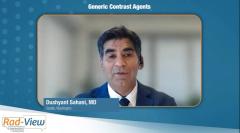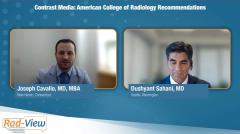
Role of Generics in Imaging
Experts discuss the concept of generics and how they have traditionally been utilized in the healthcare space.
Joseph Cavallo, MD, MBA: Let’s transfer our discussion over to the topic of generics. In general, the introduction of generics within the health care field serves to lower cost to the end user, and eventually it lowers prices for that drug class overall. An additional benefit of generics that we’ve seen throughout the health care field is an increasing number of manufacturers for specific compounds, which can add resiliency to the market supply. With that overview of generics for medicine in general, what do you have to add regarding this topic as it relates to the imaging field?
Dushyant Sahani, MD: The contrast media is important. We made a case of why it is important. Having a safe and effective contrast media is essential for strong diagnostic imaging exams. Having more choices with contrast media is equally important. If you look at the major health care imperatives nationally—even if you look at internationally—there are 3 big priorities. One is access to care, and you want to provide that at population level. Secondly, we need to provide consistency in care. The quality of care is provided at the population level. Third, we want to reduce the cost.
Having said that, we need to look at all options. How we can do that not only with appropriate use of imaging test and making sure one imaging, when ordered, is the most effective and we don’t have to order additional tests to provide answers to our referring physician. We also want to make sure the imaging test is targeted with the right protocols to answer patients’ or referring providers’ questions. We also want to make sure access is optimized, and that comes through availability of imaging techniques and contrast media, which is safe and available for use. Finally, if you have many options available, that leads to competition, [which] impacts cost…. Those things are important, and the best thing we do is if you have an agent, which is a copy of the original branded agent with a similar pharmacokinetic profile, and it has been tested extensively for its safety as well as effectiveness, then a lot of those barriers can be eliminated. Then you provide choices to health care providers in terms of what contrast media you want to choose, if cost is a bigger imperative. That is one way of using generic agents if it meets your own practice needs. Secondly, you are less constrained with supply chain issues or shortages with contrast media as the source has been diversified. I think there is clearly some wisdom, and we need to have those choices available. We sometimes focus only on our own health care here in the United States, but globally, cost is a bigger constraint and access to both imaging techniques and contrast media can be challenging. Generics can fill that unmet need.
Joseph Cavallo, MD, MBA: I agree with you. You mentioned cost and access, but I would add that anytime you’re talking to those 2 properties, it’s also an equity issue, whether that be within the United States or, as you mentioned, globally.
Transcript is AI-generated and edited for clarity and readability.
Newsletter
Stay at the forefront of radiology with the Diagnostic Imaging newsletter, delivering the latest news, clinical insights, and imaging advancements for today’s radiologists.



































